Blunted response to low oxygen of rat respiratory network after perinatal ethanol exposure: involvement of inhibitory control
- PMID: 18096598
- PMCID: PMC2375658
- DOI: 10.1113/jphysiol.2007.147165
Blunted response to low oxygen of rat respiratory network after perinatal ethanol exposure: involvement of inhibitory control
Abstract
Acute ethanol depresses respiration, but little is known about chronic ethanol exposure during gestation and breathing, while the deleterious effects of ethanol on CNS development have been clearly described. In a recent study we demonstrated that pre- and postnatal ethanol exposure induced low minute ventilation in juvenile rats. The present study analysed in juvenile rats the respiratory response to hypoxia in vivo by plethysmography and the phrenic (Phr) nerve response to ischaemia in situ. Glycinergic neurotransmission was assessed in situ with strychnine application and [(3)H]strychnine binding experiments performed in the medulla. After chronic ethanol exposure, hyperventilation during hypoxia was blunted in vivo. In situ Phr nerve response to ischaemia was also impaired, while gasping activity occurred earlier and recovery was delayed. Strychnine applications in situ (0.05-0.5 microM) demonstrated a higher sensitivity of expiratory duration in ethanol-exposed animals compared to control animals. Moreover, [(3)H]strychnine binding density was increased after ethanol and was associated with higher affinity. Furthermore, 0.2 microM strychnine in ethanol-exposed animals restored the low basal Phr nerve frequency, but also the Phr nerve response to ischaemia and the time to recovery, while gasping activity appeared even earlier with a higher frequency. Polycythaemia was present after ethanol exposure whereas lung and heart weights were not altered. We conclude that chronic ethanol exposure during rat brain development (i) induced polycythaemia to compensate for low minute ventilation at rest; (ii) impaired the respiratory network adaptive response to low oxygen because of an increase in central glycinergic tonic inhibitions, and (iii) did not affect gasping mechanisms. We suggest that ethanol exposure during early life can be a risk factor for the newborn respiratory adaptive mechanisms to a low oxygen environment.
Figures
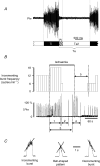
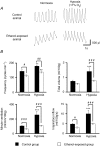
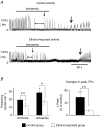
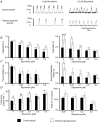
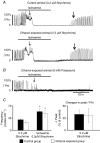
Comment in
-
Maternal drinking of alcohol: the newborn has the worst hangover.J Physiol. 2008 Mar 1;586(5):1201. doi: 10.1113/jphysiol.2008.150664. J Physiol. 2008. PMID: 18310127 Free PMC article. No abstract available.
Similar articles
-
Early chronic ethanol exposure in rats disturbs respiratory network activity and increases sensitivity to ethanol.J Physiol. 2006 Oct 1;576(Pt 1):297-307. doi: 10.1113/jphysiol.2006.111138. Epub 2006 Jul 20. J Physiol. 2006. PMID: 16857714 Free PMC article.
-
Perinatal exposure to ethanol in rats induces permanent disturbances of breathing and chemosensitivity during adulthood.Neurosci Lett. 2020 Sep 14;735:135219. doi: 10.1016/j.neulet.2020.135219. Epub 2020 Jun 29. Neurosci Lett. 2020. PMID: 32615247
-
Perinatal alcohol exposure in rat induces long-term depression of respiration after episodic hypoxia.Am J Respir Crit Care Med. 2009 Apr 1;179(7):608-14. doi: 10.1164/rccm.200703-434OC. Epub 2008 Dec 23. Am J Respir Crit Care Med. 2009. PMID: 19106308
-
Potential switch from eupnea to fictive gasping after blockade of glycine transmission and potassium channels.Am J Physiol Regul Integr Comp Physiol. 2002 Sep;283(3):R721-31. doi: 10.1152/ajpregu.00004.2002. Am J Physiol Regul Integr Comp Physiol. 2002. PMID: 12185007
-
Effect of ethanol upon respiratory-related hypoglossal nerve output of neonatal rat brain stem slices.J Neurophysiol. 2000 Jan;83(1):333-42. doi: 10.1152/jn.2000.83.1.333. J Neurophysiol. 2000. PMID: 10634876
Cited by
-
Sleep in Infants and Children with Prenatal Alcohol Exposure.Alcohol Clin Exp Res. 2018 May 31:10.1111/acer.13803. doi: 10.1111/acer.13803. Online ahead of print. Alcohol Clin Exp Res. 2018. PMID: 29852534 Free PMC article. Review.
-
Neurotoxicity of prenatal alcohol exposure on medullary pre-Bötzinger complex neurons in neonatal rats.Neural Regen Res. 2015 Jul;10(7):1095-100. doi: 10.4103/1673-5374.160101. Neural Regen Res. 2015. PMID: 26330832 Free PMC article.
-
Chronic nicotine and ethanol exposure both disrupt central ventilatory responses to hypoxia in bullfrog tadpoles.Respir Physiol Neurobiol. 2013 Jul 1;187(3):234-43. doi: 10.1016/j.resp.2013.04.004. Epub 2013 Apr 13. Respir Physiol Neurobiol. 2013. PMID: 23590824 Free PMC article.
-
Moderate ethanol exposure during early ontogeny of the rat alters respiratory plasticity, ultrasonic distress vocalizations, increases brain catalase activity, and acetaldehyde-mediated ethanol intake.Front Behav Neurosci. 2022 Nov 10;16:1031115. doi: 10.3389/fnbeh.2022.1031115. eCollection 2022. Front Behav Neurosci. 2022. PMID: 36439967 Free PMC article.
-
GluN2B Subunit of the NMDA Receptor: The Keystone of the Effects of Alcohol During Neurodevelopment.Neurochem Res. 2019 Jan;44(1):78-88. doi: 10.1007/s11064-017-2462-y. Epub 2018 Jan 6. Neurochem Res. 2019. PMID: 29307084 Review.
References
-
- Aguayo LG, Pancetti FC. Ethanol modulation of the gamma-aminobutyric acidA- and glycine-activated Cl− current in cultured mouse neurons. J Pharmacol Exp Ther. 1994;270:61–69. - PubMed
-
- Aguayo LG, Tapia JC, Pancetti FC. Potentiation of the glycine-activated Cl− current by ethanol in cultured mouse spinal neurons. J Pharmacol Exp Ther. 1996;279:1116–1122. - PubMed
-
- Barker DJ. The developmental origins of adult disease. J Am Coll Nutr. 2004;6(Suppl.):588S–595S. - PubMed
-
- Bartlett D, Jr, Tenney SM. Control of breathing in experimental anemia. Respir Physiol. 1970;10:384–395. - PubMed
-
- Burd L, Klug M, Martsolf J. Increased sibling mortality in children with fetal alcohol syndrome. Addict Biol. 2004;9:179–188. - PubMed
Publication types
MeSH terms
Substances
LinkOut - more resources
Full Text Sources

